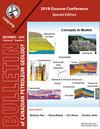中麦克默里组的技术含量告诉我们什么
Q3 Earth and Planetary Sciences
引用次数: 21
摘要
尽管McMurray组拥有丰富的测井和岩心资料,但其演替仍然难以解释。目前,了解麦克默里组沉积性质的一个基本方面是该组主要是河口沉积还是河流沉积。我们将重点放在非正式的McMurray中部,对Kearl油砂区域内的McMurray组进行了详细分析,批判性地评估了收集高分辨率技术和沉积学数据作为评估沉积环境的手段的效用,并评估了河口与潮汐影响的河流沉积环境的证据。本研究认为,Kearl油砂区中McMurray组沉积在河口点坝上。所检查的数据集包括被解释为在中潮汐状态下的内到中河口沉积地点。综合详细的技术和沉积学数据可以识别存在于海平面上的潮间带沉积物,对这些沉积物的识别提供了当地有用的地层资料。确定不同尺寸的受潮汐影响的堆积河道的序列有助于确定合并河口河道坝的地层水平,并提供海平面相对变化的近似值。本文章由计算机程序翻译,如有差异,请以英文原文为准。
What does the ichnological content of the Middle McMurray Formation tell us
Abstract Despite the abundant well-log and core data available for the McMurray Formation, the succession has remained difficult to interpret. Presently, a fundamental aspect of understanding the depositional nature of the McMurray Formation is whether or not the formation is dominantly estuarine or fluvial. Focussing on the informal middle McMurray, our detailed analysis of the McMurray Formation within the Kearl Oil Sands area critically evaluates the utility of collecting high-resolution ichnological and sedimentological data as a means to assess the depositional environments and to evaluate the evidence for an estuarine versus a tidally influenced fluvial depositional setting. This study asserts that the middle McMurray Formation within the Kearl Oil Sands area was deposited on estuarine point-bars. The examined dataset encompasses what are interpreted to be inner to middle estuarine depositional locales within a mesotidal regime. Integration of detailed ichnological and sedimentological data permits recognition of intertidal flat deposits which exist at sea level, and the identification of which provides a locally useful stratigraphic datum. Identification of successions of stacked tidally influenced channels of varying dimensions help identify stratigraphic levels of amalgamated estuarine channel bars and gives an approximation of relative changes in sea level.
求助全文
通过发布文献求助,成功后即可免费获取论文全文。
去求助
来源期刊

Bullentin of Canadian Petroleum Geology
Earth and Planetary Sciences-Geochemistry and Petrology
CiteScore
2.50
自引率
0.00%
发文量
0
期刊介绍:
The Bulletin of Canadian Petroleum Geology is a peer-reviewed scientific journal published four times a year. Founded in 1953, the BCPG aims to be the journal of record for papers dealing with all aspects of petroleum geology, broadly conceived, with a particularly (though not exclusively) Canadian focus. International submissions are encouraged, especially where a connection can be made to Canadian examples.
 求助内容:
求助内容: 应助结果提醒方式:
应助结果提醒方式:


